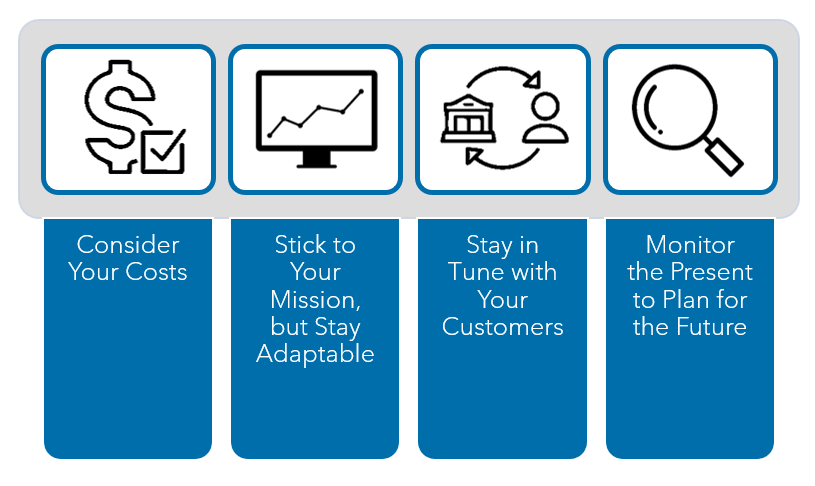Four Ways Technology Companies Can Weather a Recession or Economic Downturn

The current economic climate is challenging for all businesses, but it can be especially daunting for small to mid-sized technology and life sciences companies.
With larger companies laying off employees and making tough decisions to save money, smaller businesses may feel helpless or unsure of how to survive a recession. However, there are steps these companies can take.
By implementing cost-cutting measures, balancing preserving their strengths with pursuing innovation, staying in tune with their customers and monitoring the present to plan for the future, companies in the technology and life sciences sector can create a more stable financial foundation for the future.
While these measures may require tough decisions and careful consideration, they are crucial for small to mid-sized companies to navigate the challenges of an economic downturn and emerge stronger in the long run.

1. Consider Your Costs.
In a recession, technology companies must take a hard look at their expenses and identify areas where they can cut costs without impacting the quality of their products or services.
Tightening the budget and evaluating working capital options can help the company reduce spending. This may include renegotiating existing loans or reducing non-essential spending, such as travel or entertainment expenses.
Human resources departments at technology and life sciences companies must also manage payroll costs while retaining their top talent. To do this, they can analyze employee compensation, benefits and retirement plans to ensure they remain competitive, provide growth opportunities and offer alternative arrangements to manage payroll costs.
This includes providing flexible work arrangements, such as remote work or reduced hours, to reduce salary costs without sacrificing productivity. Partnering with a talent acquisition specialist can provide valuable insights and help create effective retention strategies that keep top employees engaged and committed to the company’s mission.
However, it’s crucial to avoid cutting costs where it counts the most. While reducing expenses is necessary, cost-cutting measures should not compromise the quality of the product or service. Scrutinize your cost management practices and marketing strategies to reduce expenses without sacrificing quality.

This means looking for ways to optimize operations and production processes to reduce costs while maintaining or improving quality. You can create a more stable financial position by identifying and reducing costs to weather an economic downturn.
2. Stick to Your Mission but Stay Adaptable.
Prioritizing what your company does well instead of trying every new solution that comes your way is critical to success.
Companies must balance preserving their strengths with pursuing innovation to withstand the pressures of a recession. For instance, companies with high margins can leverage this advantage to generate more cash flow during a downturn.

Companies should also identify areas for improvement, such as enhancing productivity, improving customer service, rethinking operations or changing offerings to keep up with the competition. These changes will require a shift to keep the company relevant, and it’s essential to vet opportunities thoroughly to pivot effectively and for a cause.
By staying true to your mission while being adaptable, your company can weather the storm of a recession and emerge stronger.
3. Stay in Tune with Your Customers.
Staying connected to customers is crucial for technology and life sciences companies to remain agile and relevant.
Understanding customers’ rapidly changing needs and demands during economic downturns can help you adapt your offerings, refine your value propositions and ultimately gain market share. This can involve conducting customer surveys, analyzing customer feedback and behavior and tracking market trends to remain competitive.
As your company begins exploring new revenue streams, such as diversifying product lines or offering begins exploring new revenue streams, such as diversifying product lines or offering new services, keep in mind that companies may be able to take advantage of tax credits, such as the R&D Tax Credit, to help recoup some of the costs of developing these new products and offerings. This credit can provide tangible tax savings and help make innovation and development possible.

To maintain customer trust, companies must prioritize transparency and assurance over their systems and organizational controls. Customers want to know that their data and intellectual property are secure and that their suppliers and partners have robust and reliable systems. Having an SOC readiness assessment performed can help you evaluate your ability to meet these demands and maintain customer trust.
By staying connected with customers and proactively responding to market trends, technology and life sciences companies can successfully navigate economically challenging times.
4. Monitor the Present to Plan for the Future.
Monitoring the present economic indicators is an essential part of planning for the future of a technology or life sciences company. The economic conditions are ever changing, and it’s important to stay updated with these changes so you can adapt your strategies accordingly.
Economic indicators such as inflation rates, consumer confidence and employment figures provide valuable insights into the economy’s overall health and can help companies make informed decisions. By keeping a close eye on these indicators, you can better understand the market and identify potential growth opportunities.
In addition to monitoring economic indicators, being prepared for future capital needs is critical for planning and implementing appropriate strategies for a technology or life sciences company. This involves forecasting the company’s cash flow requirements and identifying potential funding sources. Optimize your company’s value now to prepare future transactions for a successful outcome.

If your company is considering a transaction, even in the distant future, begin considering the financial aspects, including due diligence, valuation and deal structure, as soon as you can. Start identifying potential funding sources and preparing financial projections to attract potential investors or lenders to position your company for long-term success.
Monitoring the present economic conditions and being prepared for future capital needs are essential for planning and implementing the appropriate strategies for technology or life sciences companies. By keeping a close eye on economic indicators, companies can position themselves for long-term success and achieve their financial goals.
Learn More About Strategic Planning for Your Technology Company
Technology companies can take several steps to weather a recession effectively.
By reducing costs, re-evaluating management practices, sticking to the company’s mission, staying in tune with customers and monitoring economic indicators, a company can survive and even thrive during the recovery.
It’s essential to take a proactive approach to the business during a recession rather than panicking or losing motivation. By working with a team of experienced advisors, you can navigate the challenging landscape and emerge stronger on the other side.
If you’re interested in learning more about how your technology or life sciences company can weather an economic downturn, reach out to your Warren Averett advisor or ask a member of our team to contact you.

